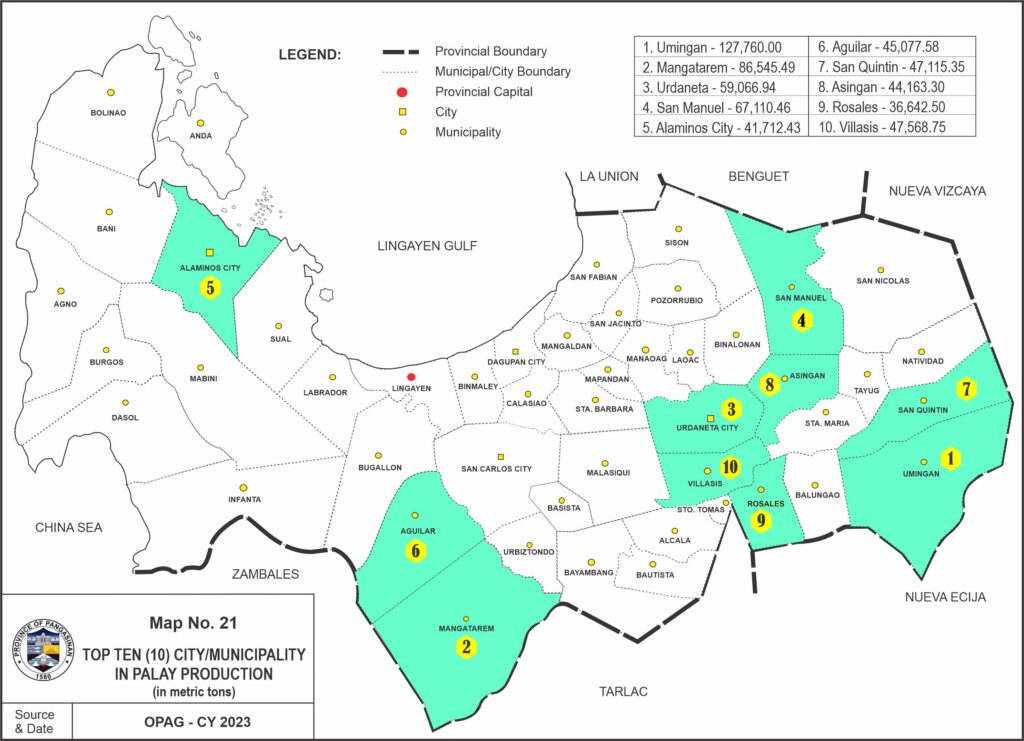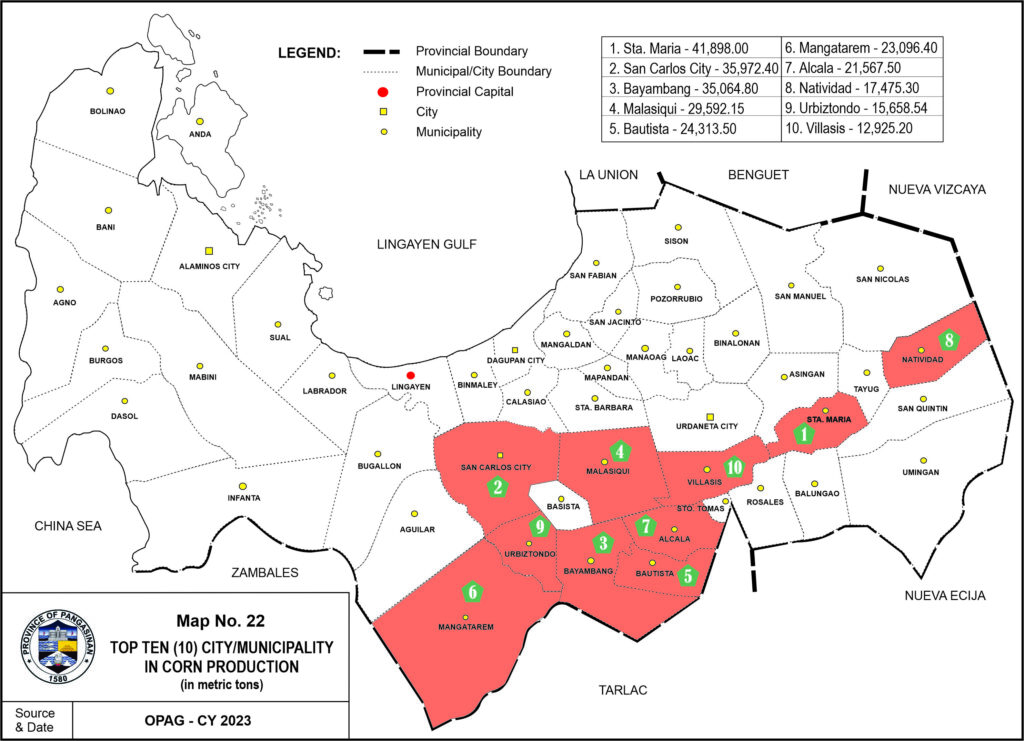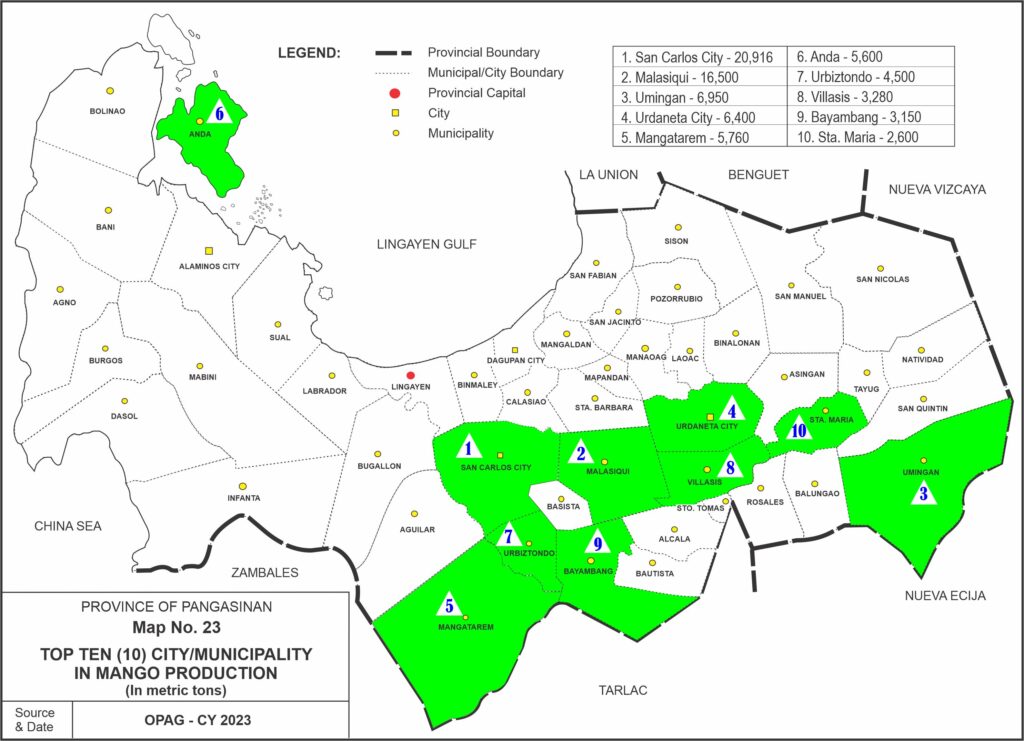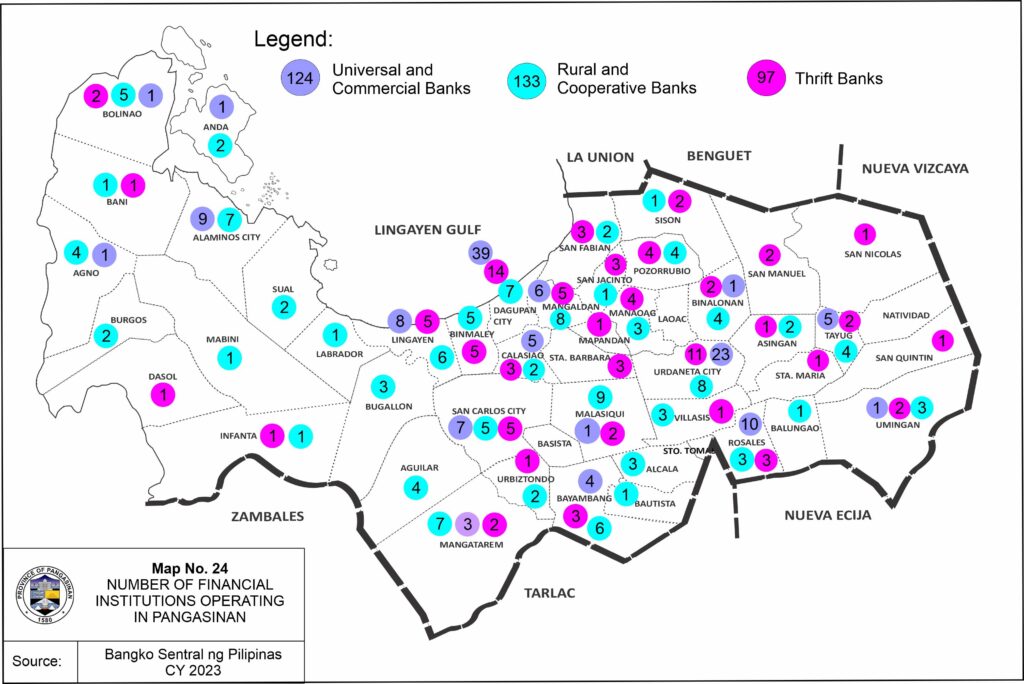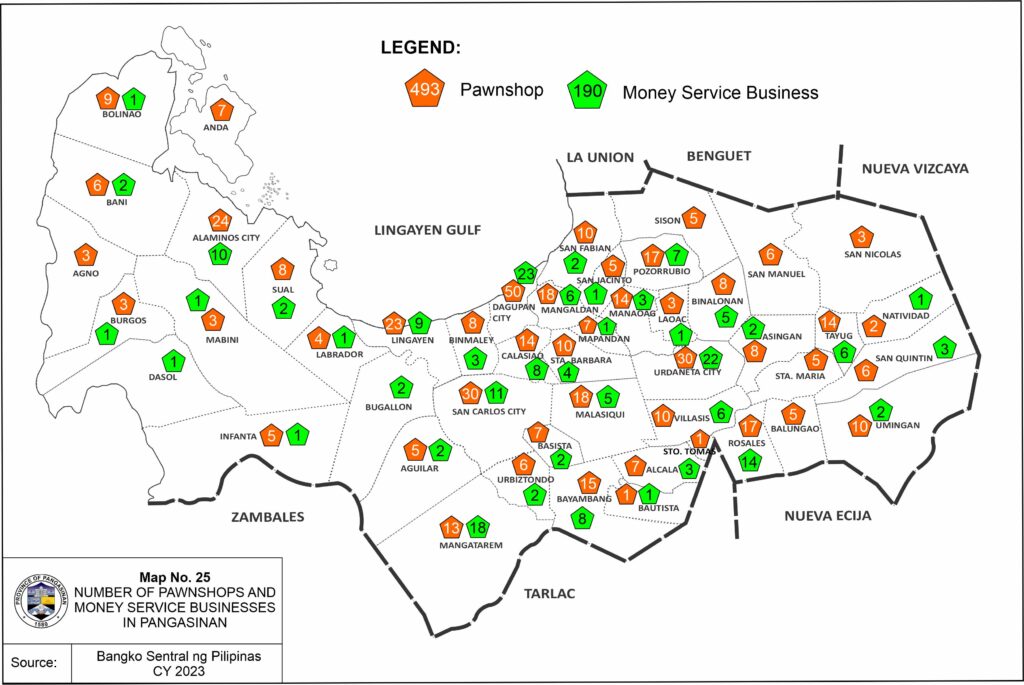This sector outlines data on the sub-sectors of Agriculture, Trade and Industry, Tourism and Investment and Price Indices. It provides information on the economic welfare of the population particularly on agriculture which plays a major role in the growth and stability of the province’s economy.
Agricultural Crops
Cereal production increased by 1.73% from 1,750,934.21 metric tons (MT) in 2022 to 1,781,170.76 MT in 2023. Bulk of the cereal production was made up of palay which accounted for 1,361,063.85 MT, lower by about 0.38% compared to previous year’s figure of 1,366,242.51 MT. The province posted a rice sufficiency level of 207% for the year in review.
For vegetables, the total production is recorded at 113,134.02 MT, a decrease of 6.73% was noted from last year’s figure of 121,305.27 MT. Root crops’ production is posted at 27,147.53 MT, while on fruits production a total of 158,229.61 MT was harvested. Also, legumes have a total of 11,484.55 MT were recorded.
The province’s top ten palay producing municipalities/cities are mostly located in the central and eastern areas. The municipality of Umingan has produced 127,760.00 MT of palay and is the top producer in the province in 2023. Followed by Mangatarem, Urdaneta City, San Manuel, Alaminos City, Aguilar, San Quintin, Asingan, Rosales and Villasis. Pangasinan remains the top 3 palay producers nationwide, based on PSA data.
On the other hand, corn production in the province increased by about 11.38% from last year’s 377,195 MT to 420,106.91 MT. From the total production generated by all municipalities in the province, Sta. Maria had the highest contribution of 41,898.00 MT. This is followed by San Carlos City, Bayambang, Malasiqui, Bautista, Mangatarem, Alcala, Natividad, Urbiztondo and Villasis. The province’s production was ranked 7th across the country.
The total mango production in Pangasinan for CY 2023 was recorded at 102,823.30 as reported by the Provincial Agriculture Office. Among the top ten (10) mango producing municipalities/cities are mostly found in the central and eastern part of Pangasinan. San Carlos City leads the highest production with 20,916 MT, followed by Malasiqui, Umingan, Urdaneta, Mangatarem, Anda, Urbiztondo, Villasis, Bayambang and Sta. Maria.
Total tobacco production for the year was recorded at 4,401,276.75 MT with an area of 2,011.28 hectares planted. The municipality of Alcala (1,230,354.95 mt) is the biggest contributor in the province with a 28% share of the provincial total.
Meanwhile, the coconut production is still pegged at 25,199,898/year, with District I having the bulk of production with 15,398,087, or 61% of the provincial total production per year. Among municipalities, Bolinao had the biggest production, representing a 25% of the provincial total.
The province has a total number of 257,052 farmers of which 58% are males and 42% are females, cultivating an area of 252,310.62 hectares. Most of these farmers are from the municipality of Umingan with 13,025.
Agrarian Reform Community (ARC) is a barangay or a cluster of contiguous barangays within a municipality where majority of the CARP-covered lands have been awarded to a critical mass of Agrarian Reform Beneficiaries (ARBs). In the province, there are 58 ARCs covering 329 barangays, with 37,811 ARBs, cultivating a total agricultural area of 95,943.8252 hectares.
Livestock and Poultry
This year’s inventory of livestock and poultry population has increased by 188%, from 5,929,598 to 11,154,955. With poultry having the largest number with 10,757,317 heads or about 96.43% of the total livestock and poultry population. Poultry population has increased by 192% from last year’s (2022) 5,612,933 to this year’s (2023) 10,757,317. Livestock population has also increased from the previous year’s 316,665 to heads or about 11.8% of the total livestock population.
The total meat production for livestock in the province is 42,290.08 MT with an average sufficiency level of 380.71%. This is based on the report of the OPVet data (Table No. 4.2.2). Also, meat production for poultry is recorded at 54,616.05 MT with a sufficiency level of 559.91%.
Fishery
Total fishery production this year has increased by 7.72% from 134,595.2573 MT in 2022 to 138,444,.6588 MT in 2023, posting a sufficiency level of 119% which implies that the fishery production surpassed the total fish demand of the province.
The province’s share to Region’s milkfish production is 97% or 138,818.74 metric tons. Across the nation, Pangasinan shares 39% of the total Philippine production of 355,425.87.
Forestry
To ensure forest protection and improve the socio-economic condition of upland farmers, activities such as reforestation, agroforestry, and fuel wood/fruit tree plantation are being undertaken. About 1,701 beneficiaries under the Integrated Social Forestry (ISF) are occupying an area of 2,911.67 hectares in the 38 barangays of Western and Eastern Pangasinan as of CY 2021 data.
Agricultural Support Facilities
There are 20 ice plants and cold storage facilities operating in the province, which primarily cater to the preservation needs of fish traders or travelers. These facilities can be found mostly in coastal municipalities of the province.
Trade & Industry
Trade and industry lead to faster productivity growth in economic development. In 2023, the province had a total number of 15,311 micro small and medium enterprises (MSMEs), that contributed to the local economy. The total number consists mostly of micro enterprises whose income is Php 3M and below.
The province has recorded 76 manufacturers in 2022 with different product lines coming from the different cities and municipalities compared to the 121 manufacturers recorded during 2021.
The average Consumer Price Index (CPI) for all income household for all items is 122.5 with the purchasing power of peso being 0.82, while the province’s inflation rate increased from last year’s 5.70 to 6.00 this year.
As recorded by DTI, there are 15,370 registered establishments in the province with a total investment amounting to Php 2,720,569,510. Still Personal Services sector contributes the highest investment with 54.21% share. While Manufacturing Sector contributes the least with 1.79%.
Dominating the Business Name Registration, are the Trading and Personal Services sectors with about 48.96% and 43.20% of the total number of registered establishments, respectively. On the other hand, Agribusiness sector has the least with only 2.01% of the total number of establishments.
From the registered business establishments in 2023, approximately 27,329 people were employed. Majority of the employed group is in the trading sector with 48.96%, followed by personal services (43.20%), manufacturing (3.68%), industrial services (2.16%), and agribusiness (2.01%).
The province has two (2) registered Call Centers / Business Process Outsourcing or BPO as of CY 2023 as recorded by DTI.
Financial Institutions
There are 1,049 Financial Institutions operating in the province, as registered under the Bangko Sentral ng Pilipinas. Of which 683 are Pawnshops and Money Service Businesses and 12 are non-Banking institutions.
From these financial institutions, about 432 automated teller machines (ATM) are strategically installed in various places in the province for the convenience of our constituents.
Tourism
Based on the Provincial Tourism, Culture and Arts Office, the survey of tourist arrivals based on accommodation establishments registered a total of 663,676 tourists, both domestic and foreign. On the other hand, survey on day tourist based on tourist destinations, accounted some 8,401,897 domestic and foreign tourists, which are dominated by the Manaoag Pilgrims and beaches in Bolinao, Alaminos and Lingayen, with at least 76% of the total number of day tourist.
There are 836 accommodation establishments (AE) in the province, which employ about 3,577 employees. These establishments have a total number of 6,860 rooms. District 1 has the highest number of AE’s with 548, followed by District IV with 99 AE’s.
A total of 48 shopping malls are strategically located in the province which provides employment opportunities to Pangasinenses and contributes to the economic growth of the province.
Festivals can be religious, cultural or both, where these are held to honor their local Roman Catholic patron saints, to commemorate local history and culture, to promote the community’s products, or to celebrate a bountiful harvest. In the province, all municipalities and cities celebrate their Town Fiestas and other festivities as scheduled.
There are also public markets situated in all cities and municipalities in the province, with a scheduled market days.

